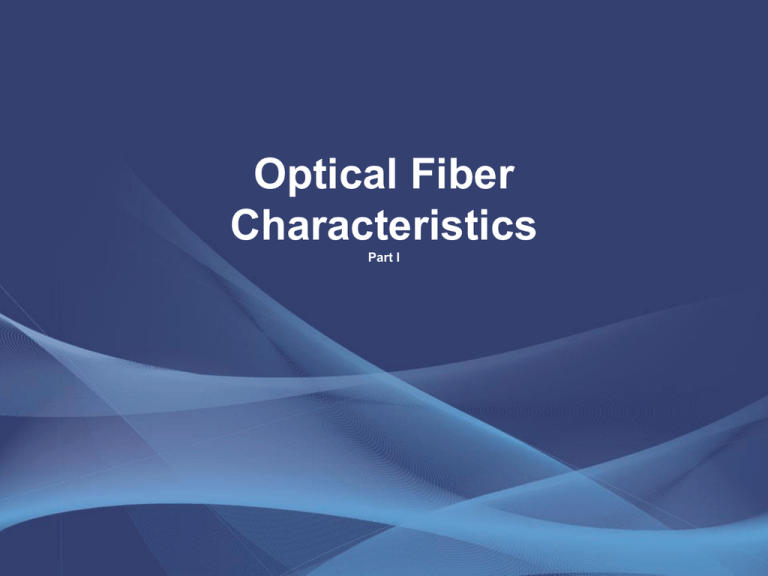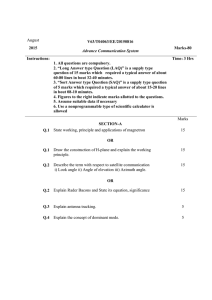Optical Fiber Characteristics Part I
advertisement

Optical Fiber Characteristics Part I In this lecture • • • • • Modes Total internal reflection Refractive Index Profiles Dispersion Modal Dispersion Modes One of the most important characteristics used to distinguish types of fiber is the number of potential paths light can take through it. It may seem that light would go straight through the fiber core, following all of its curves, until it comes out the other end. The light itself is a complex combination of electrical and magnetic waves, and their wavelengths can be many times smaller than the core of the fiber. Light actually has many potential paths, or modes it can follow, depending upon the size of the core and the light’s angle of entry. Light travels as waves of energy. Waves of light have different wavelengths (the distance between the top of one wave and the top of the next). Different colors of light have different wavelengths. Purple and blue light waves have short wavelengths. Red light has a longer wavelength. Total internal reflection • Total internal reflection (TIR) is the basis for fiber optic transmission TIR depends on the principle that light passing through a medium of a given Refractive Index (RI) will be reflected off the interface with a medium of a lower refractive index if it hits the interface at or above the critical angle, which is determined by the difference between the refractive indices of the two media. So, optical fiber is manufactured with a core having an RI slightly higher than that of the cladding surrounding it. As a result, light entering the end of the fiber will be reflected off the interface with the cladding, and guided through the fiber. • This angle of incidence is known as the critical angle; it is the largest angle of incidence for which refraction can still occur. • For any angle of incidence greater than the critical angle, light will undergo total internal reflection. Continue Continue • The number of modes possible in a length of fiber depends on the diameter of the core, the wavelength of the light, and the core’s numerical aperture. • The numerical aperture can be calculated using this formula: For example, if the core has an RI of 1.48 and the cladding has an RI of 1.46, we can calculate: Refractive Index Profiles • What happens when the light rays entering a fiber take slightly different paths, some entering at sharper angles, some at shallower angles? The light can follow modes ranging from a straight line through the fiber (zero-order mode) to a low number of reflections (low-order mode) to a high number of reflections (high-order mode). Depending on a fiber’s construction, it can allow only one mode, or more than 100,000 modes. The difference is in the fiber’s refractive index profile. • The refractive index profile defines the relationship between the refractive index of the core and that of the cladding. • There are two criteria used to define the relationship: the mode, and the index, which describes the interface between the core and the cladding. • When the core has one refractive index (RI) and the cladding another, this is known as stepindex fiber. Continue • If the fiber has a large enough diameter, there is • • • • room for the light to take a number of different possible paths, or modes, by way of reflection This is referred to as multimode fiber. There are three main refractive index profiles are: Multimode step-index fiber Multimode graded-index fiber Single-mode step-index fiber Dispersion • Dispersion is the spreading of light as it travels away from its source. • The light spreads because different components of it travel at slightly different velocities, depending on the conditions in the medium through which it is traveling and the wavelengths that make up the light. Continue There are different kinds of dispersion, however, and the kind that is taking place depends on several factors in the fiber and in the light itself. The greatest effect of dispersion is that as the light spreads, it can degrade or destroy the distinct pulses of the digital signals in the light by making them overlap each other. The effect grows more pronounced as the distance the light travels increases. Continue To prevent signal loss due to dispersion, it is necessary to keep the pulses far enough apart to ensure that they do not overlap. This limits the signals to a bit rate that is low enough to be only minimally affected. Restricting the bit rate places a limit on the fiber’s bandwidth , or the amount of information it can carry. Continue The types of dispersion that affect optical fiber • • • • • are: Modal dispersion Material dispersion Waveguide dispersion Chromatic dispersion Polarization-mode dispersion Modal dispersion • Modal dispersion results from light taking different paths, or modes, as it passes through the fiber The number of modes the light can take is determined by the diameter of the fiber core, the refractive indices of the fiber core and cladding, and the wavelength of the light. • The ray that goes straight down the center of the core without reflecting, arrives at the other end first, other rays arrive later. Thus light entering the fiber at the same time exit the other end at different times. The light has spread out in time. • The spreading of light is called modal dispersion Modal dispersion is the dominant source of dispersion in multimode fibers. Modal dispersion does not exist in single mode fibers. Continue • Modal dispersion comes from the fact that the index profile of the multimode fiber is not perfect. • Depending on the mode, some parts of the light will pass through the fiber more quickly than others. • The difference in travel time can cause parts of the light pulses to overlap each other, or in extreme cases to arrive in a different order from the order they were transmitted. Continue The graded index profile was chosen to theoretically allow all modes to have the same group velocity or transit speed along the length of the fiber. By making the outer parts of the core a lower index of refraction than the inner parts of the core, the higher order modes speed up as they go away from the center of the core, compensating for their longer path lengths. The formula for determining the refractive index of a material: n = c / v, where n is the refractive index, c is the speed of light in a vacuum, and v is the speed of the wavelength of light through the material. Continue • Methods for overcoming modal dispersion include: 1- Lower bit rate increases the gap between bits in the signal. • While dispersion will still affect them, they will not overlap one another, and will still be usable. • The drawback of this method is a reduction in bandwidth, reducing the fiber’s ability to carry data. 2- Graded index fiber






